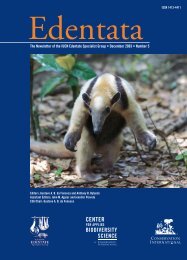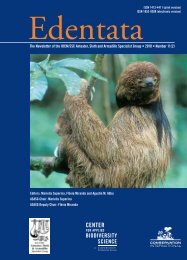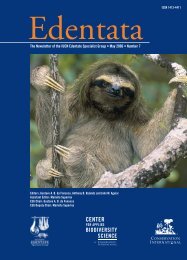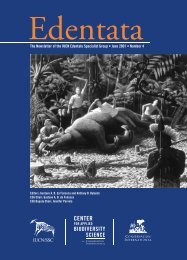Edentata 11(1) - Anteater, Sloth & Armadillo Specialist Group
Edentata 11(1) - Anteater, Sloth & Armadillo Specialist Group
Edentata 11(1) - Anteater, Sloth & Armadillo Specialist Group
You also want an ePaper? Increase the reach of your titles
YUMPU automatically turns print PDFs into web optimized ePapers that Google loves.
<strong>Edentata</strong> — Instructions to Authors<br />
<strong>Edentata</strong> is the official publication of the IUCN/SSC<br />
<strong>Anteater</strong>, <strong>Sloth</strong> and <strong>Armadillo</strong> <strong>Specialist</strong> <strong>Group</strong>. It<br />
aims to publish information that contributes to the<br />
conservation of xenarthrans.<br />
A broad range of topics is welcomed and encouraged,<br />
including taxonomy, systematics, genetics, biogeography,<br />
ecology, conservation, behavior, and health.<br />
Manuscripts must describe original research findings<br />
that have not been published or submitted simultaneously<br />
to other journals. Any overlap of contents with<br />
already published papers should be minimal.<br />
<strong>Edentata</strong> accepts manuscripts of original research<br />
findings related to any aspect of xenarthran conservation.<br />
It also encourages submission of short communications,<br />
field notes, thesis abstracts, news items,<br />
recent events, book reviews, congress announcements,<br />
and the like.<br />
Manuscripts may be written in English, Portuguese<br />
or Span ish. Authors whose first language is not English<br />
should please have their texts carefully reviewed by<br />
a native English speaker.<br />
Once the manuscript has been received, the editors<br />
will perform a first evaluation. Manuscripts not satisfying<br />
the editorial instructions will be returned to the<br />
author without review.<br />
Conservation research ethics<br />
When submitting their work, authors must confirm<br />
in written that their research protocols have been<br />
approved by an authorized animal care or ethics committee<br />
and/or the authors had the necessary permits<br />
to carry out their research. Authors must be aware of,<br />
and adhere to, all laws, treaties and regulations currently<br />
applying to their work.<br />
Editorial instructions<br />
Format<br />
Please type all parts of the manuscript (including<br />
references, figure and table legends, and annexes) in<br />
12-point font, Times New Roman or Arial. Justify<br />
the text to the left and double-space it throughout.<br />
Do not use footnotes.<br />
Number all pages, including the title page, in the<br />
lower right corner. Submit the main text as a DOC or<br />
RTF file, and the tables and figures in separate files.<br />
Style<br />
The style of writing should be simple and concise.<br />
Avoid large, complex sentences that are difficult to<br />
read.<br />
Words in other languages<br />
Words in other languages, including allowed abbreviations,<br />
should be written in italics.<br />
Nomenclature<br />
The taxonomic nomenclature must follow the<br />
updated rules and recommendations of the International<br />
Code of Botanical Nomenclature and the<br />
International Code of Zoological Nomenclature. Scientific<br />
names, of generic or inferior category, must be<br />
written in italics.<br />
Abbreviations<br />
Use the decimal metric system for all measurements.<br />
Abbreviate units of measure when preceded by a<br />
numeral and write them out in all other cases (e.g.,<br />
5.4 m or several meters).<br />
Spell out numbers at the beginning of a sentence.<br />
Also, spell out all numbers under ten unless they<br />
are associated with units of measure. Example: three<br />
armadillos, one sloth and 12 anteaters.<br />
Express fractions as decimals (e.g., 0.25 instead of ¼).<br />
Use a decimal comma in Spanish and Portuguese, and<br />
a decimal point in English texts. The symbols > and<br />
< may be used if accompanied by a dimension (e.g.,<br />
< 2 m).<br />
Abbreviations should end with a period, except those<br />
corresponding to measurements and distances, such<br />
as kg, m, km, μm, which are symbols. Use the abbreviation<br />
Fig. or Figs. when referring to figures within<br />
the text (e.g., Fig. 1, Figs. 2–4; as shown in Fig. 2…).<br />
Leave a space between numbers and their dimensions<br />
(e.g., 2 km or 07:15 hr; do not write 2km or<br />
07:15hr).<br />
<strong>Edentata</strong> no. <strong>11</strong>(1) • 2010 83














